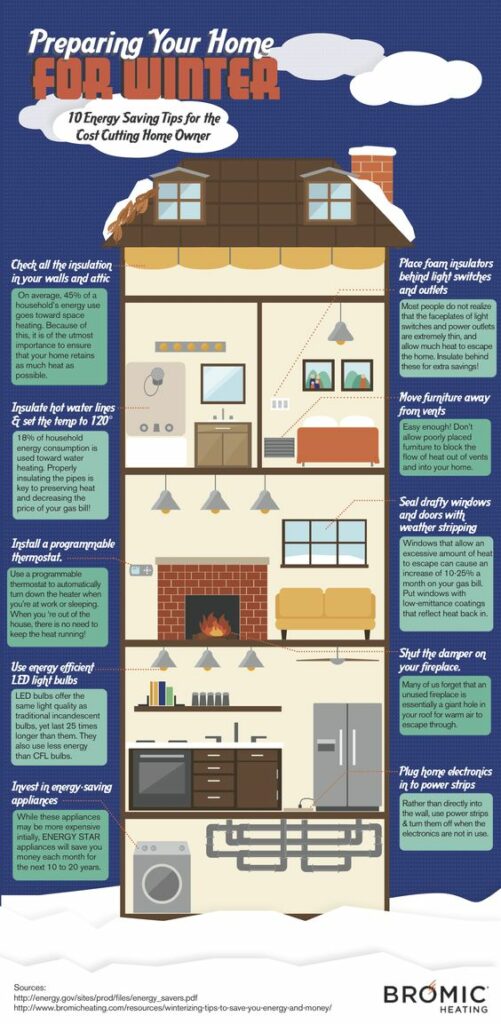Securing your home against winter is always a important for homeowners, no matter where you live. Regardless of what direction the cost of heating oil, propane, and other fuels is heading, it makes good sense to ensure that you and your family stay warm for the winter season.

There are a surprising number of easy things you can do at minimal cost that can maximize energy savings this winter. Below are suggestions for budgets under $100.
Caulk around windows. Warm air can escape, and cold air can enter your house if the area around your windows has cracks. Caulking needs to be replaced periodically, and you should check every fall for holes that need to be patched, as well as holes anywhere outside your house. Basic caulk gun and tubes of caulk to fill gaps in siding, windows, and doors. For drafty windows and doors, don’t just fill the gaps on the outside pull the molding off to fill the insulation gaps around the window jamb. You can use a can of low-expansion window foam instead of caulk.

Plastic film window insulating kit, enough for five to six windows. Use caulk rolls for windows. Window insulation film is another option to provide a layer of protection for single pane windows.
It’s a must to change your furnace and air conditioning filter on a regular basis, at least every three months or more often. Clogged filters reduce heating and cooling efficiency and can reduce the useful life of the appliance.

Replace weather-stripping around doors. If you can see light around the edges of your doors, you need new weather-stripping. A small weather-stripping costs you five or six dollars, and it will save you hundreds of dollars in electrical bills. Adding a sweep strip to the bottom of the door helps to block drafts. Door threshold/sweep strip to fill air leaks beneath doors.

Close up your fireplace when you are not using it. Make sure your flue closes all the way, and check whether you can feel air coming in when it’s closed. Glass doors around your fireplace opening are another way to keep warm air in and cold air out of your house.
Add heavy drapes and rugs. Changing light summer drapes for heavy winter drapes was common in earlier times. Drapes can keep the room warmer, while putting down rugs provides a layer of insulation above the floor.
For a more expensive but permanent fix, is to replace old windows with double windows. Windows now have a higher R factor that keeps heat in the home and the cold outside. I replaced most of my windows on my home and found a noticeable effect on the heating bill.
Improve your insulation. Insulation deteriorates over time, so you may want to add more material in your attic. Other places to add insulation are in crawl spaces and exposed areas of decks and creating a false ceiling in unfinished basements and insulating between that ceiling and the living area. An insulating cover over your attic opening also helps trap in the heat.

Cover your water heater. You can buy a water heater blanket for around $20 at the hardware store that will keep the tank from losing heat as quickly, saving you money on your heating bill.

Get a programmable thermostat. The newest thermostats can learn your family’s habits and set themselves to keep the house cooler when no one is there and warmer when the home is occupied. You can also purchase a more basic programmable thermostat. Prices vary considerably, depending on how sophisticated you want your thermostat to be.
Lower your water heater temperature. You can lower it from 140 degrees to 120 with no ill effect. And 120 degrees is the temperature recommended by the Consumer Product Safety Commission. The lower the thermostat to 68. It’s actually more comfortable to sleep in a colder home, and you can always add more blankets. When you’re awake, wear a sweater or sweatshirt to stay comfortable with a lower thermostat setting.
Most ceiling fans have a switch, either on the motor housing or remote control, that allows you to reverse the fan-blade rotation. In summer, the blades rotate counterclockwise to blow down cooling breezes. But in winter, reverse the blade rotation so they blow up. That way, the fan will force warm air trapped at the ceiling down into the room.
Reduce heat loss and save energy, and money, by insulating all of your hot-water pipes. The insulation will help keep the water hot inside the pipe, so your boiler or water heater won’t have to work so hard. Also, you won’t have to waste as much time or water waiting for hot water to flow out of the faucet or shower head. Pipe insulation comes in two basic types: foam-rubber sleeves that you slip onto the pipe, and insulated wraps that you wind around the pipe.


6 comments for “Securing your Home against Winter”